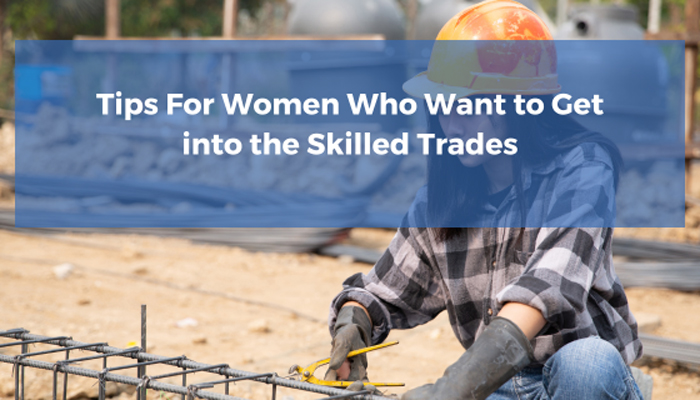Tips for women who want to get into the skilled trades

According to official figures, only 8% of skilled trades who work full-time are women, and women make up just 16% of the construction sector workforce. But despite these disappointing statistics, there is some good news. More and more women are considering getting into skilled trades, and there has been an increase in the number of women taking up courses and apprenticeships in the UK over recent years.
Below, the experts at MyJobQuote.co.uk explain why a move into the skilled trades is worth considering and offer some essential tips to help you succeed.
Why You Should Consider a Move Into the Skilled Trades
Builders, roofers and carpenters, as well as plumbers, electricians and locksmiths, are all in short supply. So, there’s a high demand across the UK for these skills. A strong job market also means you can expect pay to be competitive should you decide to work for a company.
Moving into the skilled trades also provides an opportunity for you to work for yourself. This could give you more say in the type of work you take on and the hours you want to work – making it an attractive option for those who also need to juggle childcare.
Builders, plumbers and electricians can typically charge a day rate between £150 and £280. Plasterers, kitchen fitters and, painters and decorators meanwhile can typically charge a day rate between £120 and £180. So, there are plenty of worthwhile career options.
Aside from good rates of pay, job satisfaction tends to be much higher in the skilled trades than with those doing repetitive work and office-based jobs. Being able to see a project from start to finish and have something tangible to show for your efforts can be just as rewarding as a competitive salary.
With these obvious benefits, you may be thinking that a move into the skilled trades could be for you. If so, the following tips will help you get started.
Pick a Trade That You Think You’ll Enjoy
Going into a skilled trade can take a bit of commitment as you’ll need to gain recognised qualifications and experience if you want to be taken seriously or wish to start a reputable business. So, it’s important to pick a trade that you think you’ll enjoy or find interesting. This will make learning and working far easier.
If you’re unsure whether a particular trade is right for you, look out for college open days and short courses to try before committing to a specific career path or enrolling onto a full-time course.
Organisations and businesses that are holding recruitment drives often have taster days, but if there’s nothing in your area, reach out to local trades to see if you can shadow someone for a day or two.
Choose a Way in That Suits You
There’s more than one way into the skilled trades. So, rather than going with the most obvious option, it’s important to choose a route that suits you.
Full-time and part-time college courses and apprenticeships are the most common routes into the skilled trades, but you may be able to do an intensive training course if you’re keen to get started, and on-the-job training can be a good way into some trades such as plastering.
Much of the time, you can start with a basic qualification, such as an NVQ Level 1 certificate and build on that as you progress in your career. So, don’t feel you need to learn everything in one go.
Know What Qualifications You’ll Need to Get Where You Want to Be
It’s crucial to do your research when you’re thinking about moving into the skilled trades. Know what qualifications you need to get where you want to be.
If you’re keen to start working and earning money, what’s the minimum qualification you need to be able to work safely and legally? Are there any other professional certificates and registrations that you’ll need? Be aware that this can vary depending on whether you're working as an employee, contractor, or self-employed.
Find Support
Entering into a skilled trade as a woman can be intimidating, so it’s a good idea to find support.
Look for professional women’s networks in your local area, and don't be afraid to reach out to other tradeswomen for advice. There are also national organisations, such as Women and Manual Trades (WaMT), that offer direct support, training and funding to individuals.
If you’re thinking of working for someone else, look for a company with a good track record of employing women and check they have a reputation for looking after their employees. Some of the larger firms employing trades operate mentoring schemes to ensure they’re fostering a supportive work environment.
Get Out There and Get Noticed
Once you’re ready to work, it’s important to get yourself out there and get noticed. You may find you stand out simply because of your gender but don't shy away from this – exploit it.
If you’re setting up on your own or with other tradeswomen, use this niche to find your customers. Many homeowners – especially those who live alone or are vulnerable – state they would prefer to have a female rather than a male tradesperson in their home.
Even if you suspect that someone’s employed you simply to meet their diversity targets, don’t be put off. They’ll recognise your true worth as soon as you start working.
Add your comment

- Administration 1
- Building Design, Planning, Development 1
- Catering 3
- Construction 5
- Contracts, Projects, Bids 3
- Energy Management 1
- Engineering, Maintenance 15
- Estates, Property 6
- Facilities Management (main) 26
- Hard Services 15
- Health & Safety 1
- Management 6
- M&E 4
- Operations 12
- Sales & Marketing 3
- Soft Services 7
- Sustainability 2
- ICT, Technical 1
- Workplace 2


